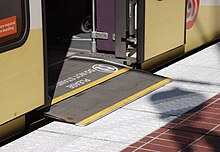
The Metropolitan Area Express (MAX) is a light rail system serving the Portland metropolitan area in the U.S. state of Oregon. Owned and operated by TriMet, it consists of five lines connecting the six sections of Portland; the communities of Beaverton, Clackamas, Gresham, Hillsboro, Milwaukie, and Oak Grove; and Portland International Airport to Portland City Center. Trains run seven days a week with headways between 30 minutes off-peak and three minutes during rush hours. In 2023, MAX recorded an annual ridership of 23,446,700.

The Portland Streetcar is a streetcar system in Portland, Oregon, that opened in 2001 and serves areas surrounding downtown Portland. The 3.9-mile (6.3 km) NS Line runs from Northwest Portland to the South Waterfront via Downtown and the Pearl District. The Loop Service, which opened in September 2012 as the Central Loop, runs from Downtown to the Oregon Museum of Science and Industry via the Pearl District, the Broadway Bridge across Willamette River, the Lloyd District, and the Central Eastside Industrial District and added 3.3 miles (5.3 km) of route. In September 2015 the line was renamed as the Loop Service, with the A Loop traveling clockwise, and the B Loop traveling counterclockwise. The two-route system serves some 20,000 daily riders.

The Siemens–Duewag U2 is a type of light rail vehicle (LRV), built by consortium of Siemens, Duewag and Wegmann & Co built between 1968 and 1990.

The Siemens SD-100 and SD-160 are two related types of high-floor light rail vehicles (LRV), manufactured by Siemens Mobility for the North American market. A total of 431 vehicles were built by Siemens in Florin, California from 1992 to 2013.

The Xochimilco Light Rail is a light rail line that serves the southern part of Mexico City. It connects to, but is not considered a part of the Mexico City Metro. Rather, it is operated by the Servicio de Transportes Eléctricos (STE), the authority that operates Mexico City's electric trolleybus system and formerly operated the municipal electric tram system.

The Siemens S70 and its successor, the Siemens S700, are a series of articulated low-floor light-rail vehicles (LRV) and modern streetcars manufactured for the United States market by Siemens Mobility, a division of German conglomerate Siemens AG. The series also includes a European tram-train variant, the Siemens Avanto.
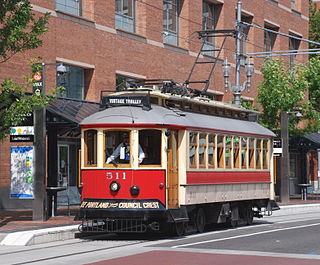
The Portland Vintage Trolley was a heritage streetcar service in Portland, Oregon, United States, that operated from 1991 to 2014. It operated on a portion of the MAX light rail system, and for a brief time also operated on the Portland Streetcar system, in downtown and nearby areas. Service was provided with replicas of a type of Brill streetcar, nicknamed the "Council Crest" cars, which last served Portland in 1950. The service was managed by Vintage Trolley Inc., a non-profit corporation, and the cars were owned and operated by TriMet, Portland's transit agency. For 18 of its 23 years, the service followed a 2.3-mile (3.7 km) section of what is now the MAX Blue Line, between Lloyd Center and the west end of downtown. In September 2009, the route was changed to a 1.5-mile (2.4 km) section of the MAX system, along the transit mall in downtown Portland, from Union Station to Portland State University (PSU).

The Škoda 03 T is a three-section low-floor tram developed by Škoda Transportation and Inekon Group. The design was introduced in 1996, and the first car was completed in 1998. The joint venture between Škoda and Inekon was dissolved in 2001, after which Škoda continued to sell the 03 T, while Inekon formed a new partnership with DPO, known as DPO Inekon, and in 2002 began selling a nearly identical version of the Astra, under the name Trio.
The opening of the Metro Blue Line in 2004 marked the beginning of Metro Transit's expansion into rail transit, 50 years after the last Twin Cities Rapid Transit streetcars were taken out of service. Several new rail transit projects are either under construction or in planning stages and more are expected to be explored in the near future. Metro Transit will likely be acquiring a significant amount of rolling stock as these new projects move forward.
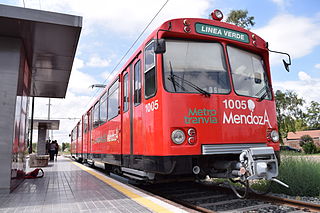
The Metrotranvía Mendoza is a public light rail transport system for the city of Mendoza, Argentina, served by articulated light rail cars operating on newly relaid tracks in former-General San Martín Railway mainline right-of-way.
Inekon Trams, a.s. is a manufacturer of trams, or streetcars, located in the Czech Republic, and has supplied new trams to several cities in the Czech Republic and the United States. The company also carries out modernisation and repair of trams, as well as track reconstruction. It is a joint-stock company.
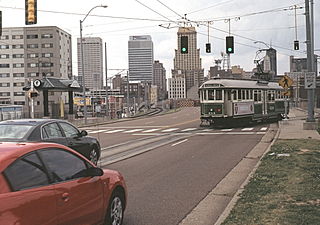
The Madison Avenue Line is a line of the Memphis Area Transit Authority trolley system. The trolley line began operating in 2004, and cost $56 million to build. It consists of 2.2 mi (3.5 km) of double track along Madison Avenue with six stops stretching into Midtown Memphis. The line was built to connect the Main Street system to the Medical District just east of Downtown Memphis. Trolley service has been suspended since April 2014, after two trolley cars caught fire within a span of six months. Buses have been serving the line since then, but MATA plans to restore trolley operation to the line eventually.

Metro is a transit network in Minnesota serving the cities of Minneapolis and Saint Paul. It also provides service to some suburban areas. As of 2022, the system consists of two light rail lines and five bus rapid transit (BRT) lines all of which are operated by the local public transit company: Metro Transit. The five lines connect Downtown Minneapolis and St Paul with Bloomington, Minneapolis-St Paul International Airport, Roseville, Richfield, Burnsville and Brooklyn Center.
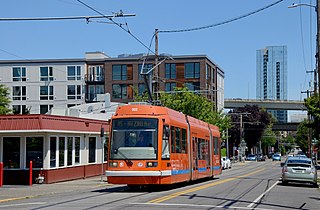
The North South Line is a streetcar service of the Portland Streetcar system in Portland, Oregon, United States. Operated by Portland Streetcar, Inc. and TriMet, it travels 4.1 miles (6.6 km) per direction from Northwest 23rd & Marshall to South Lowell & Bond. The line serves 39 stations and connects Portland's Northwest District, Pearl District, downtown, Portland State University (PSU), and South Waterfront. It runs every day of the week between 15 and 18 hours per day and operates on headways of 15 to 20 minutes.

The Alstom Flexity is a family of trams, streetcars, and light rail vehicles manufactured by Bombardier Transportation until 2021, when French company Alstom took over Bombardier. As of 2015, more than 3,500 Flexity vehicles are in operation around the world in Europe, Asia, Oceania, and North America in 100 cities among 20 countries internationally. Production of the vehicles is done at Bombardier's global production plants and by local manufacturers worldwide through technology transfer agreements.
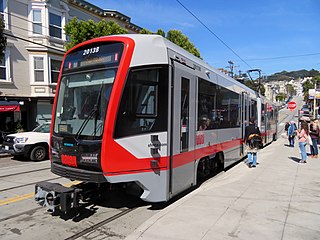
The Siemens S200 is a high-floor light rail vehicle (LRV) manufactured by Siemens Mobility in Florin, California, beginning service in 2016.

The Siemens SD-400 and SD-460 are light rail vehicles (LRV) that were manufactured by Siemens Mobility between 1985 and 2005 for the North and South American markets. The SD-400 was built under Siemens' joint venture with Duewag and assembled at both Duewag's factory in Düsseldorf, West Germany and the Siemens factory in Florin, California. Siemens purchased Duewag in 1999 and the SD-460 was assembled entirely at the Siemens factory in California.

A bridge plate, or bridgeplate, is a mechanical, movable form of wheelchair ramp that is used on some low-floor light rail vehicles (LRVs) to provide for wheelchair access. The bridge plate extends from the vehicle to the platform, which must be raised to close to the level of the floor of the vehicle so that the wheelchair need not travel over an excessively steep ramp. Some low-floor buses also use bridge plates to provide for wheelchair access, but many low-floor buses instead use a ramp that normally serves as part of the floor but can be flipped out through the door onto the curb or street; in this case the ramp is long enough that it can serve as a true wheelchair ramp rather than a bridge without being excessively steep.

The TriMet transit system, serving the Portland metropolitan area in Oregon, owns and operates two different rail transit systems: a light rail system known as MAX, and a commuter rail system known as WES. The fleet of 145 MAX electric light rail vehicles (LRVs) includes five different models, designated by TriMet as "Type 1" through "Type 6". All types are used on all of the MAX lines, but the Type 6 cars – which will gradually replace the Type 1 cars – are still being delivered and have not yet begun to enter service. The comparatively very small WES fleet includes three different types of diesel commuter rail cars.


